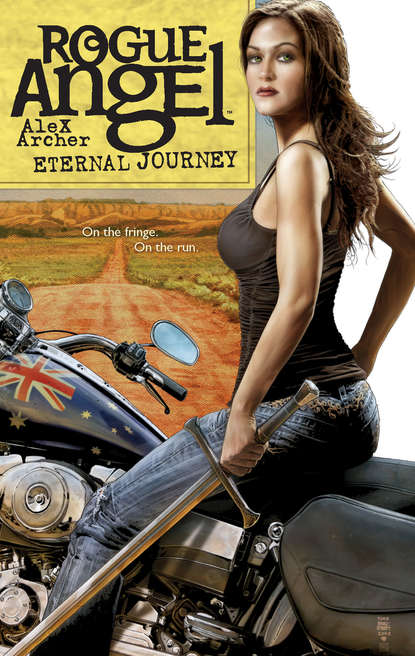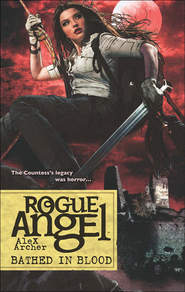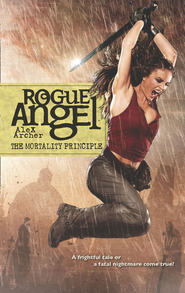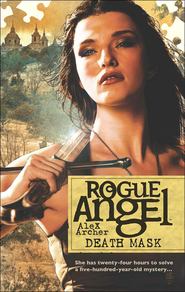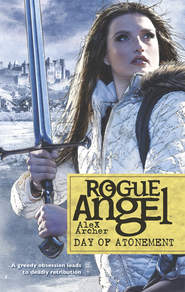По всем вопросам обращайтесь на: info@litportal.ru
(©) 2003-2025.
✖
Eternal Journey
Автор
Год написания книги
2019
Настройки чтения
Размер шрифта
Высота строк
Поля
“Thanks, Oliver.” Annja pointed to the north. “Could you get some more on the skeletons, please. That fellow working over there by himself. He’s uncovered quite a bit this morning. You can see the whole skull now.”
Oliver made a face. “More bone shots. Sure.”
The archaeologists labored in a long bowl-like depression, concentrating on a section of midden at the base of a hill, a layer of soil that was stained dark by the decomposition of refuse left behind by people who lived a long time ago. The southern section had fragments of stone tools, bits of crude jewelry and pottery chips, the latter of which obviously fascinated Wes. He was attentive with even the smallest piece.
Annja watched him with detached envy. It was a fascinating dig, and a part of her wished she was working it, not just hosting a television segment highlighting the site. Three and a half days of filming and interviews for a one-hour slot on Chasing History’s Monsters. She held back a laugh; there’d been no monsters here in this desolate stretch in a forest preserve northwest of Sydney, but she knew her producer would fabricate one. He’d come up with some beast that supposedly either lured the ancient Egyptians to Australia or prevented them from leaving—some creature that had enough myths and legends swirling around it to attract good viewing numbers.
The features of the midden drew Annja’s thoughts back. Discolorations spoke of the human impact here, such as spots where posts had been set for houses and hearths had been dug for cooking. Most fascinating were the unearthed stones covered with carvings.
Egyptian hieroglyphs, these archaeologists were certain. Others disputed it, claiming they were merely unusual aboriginal petroglyphs. She’d seen plenty of petroglyphs in books and on various Internet sites, and pictographs—paintings on rocks that usually held some religious meaning. She had to side with Wes. They certainly did look like Egyptian hieroglyphs. One of the more distinct carvings was of a slight woman with the head of a cow. One of her arms was stretched above her head; the other arm had been chopped off when the stone broke.
“Hathor,” Wes had explained. “The wife of Horus. She was an ancient goddess, dating to dynastic times, maybe earlier. Nothing aboriginal about her and Horus.”
Annja and her crew had agreed not to give the exact location of the dig. Wes and the foundation had been adamant about that. They had enough problems with errant hikers trudging over out of curiosity. Too much publicity would mean they’d have to up their security to protect against looters and tourists, and that would cut into what Wes called a “damn scant budget.”
There was a second dig about a mile away, on the other side of the ridge in a lightly wooded section. Smaller and not nearly as interesting as this, Annja thought, though certainly part of the same ancient city. University of Sydney graduate students were working there to uncover more hieroglyphs. A third Egyptian dig was taking place near Brisbane, and Annja had lobbied to visit that site, too, as it was the most recent. But her producer cited timing and money, and so she had grudgingly settled solely on Dr. Michaels’s team.
“This is all considered fringe archaeology anyway,” Doug Morrell had argued, because not all the experts agreed it was Egyptian. Not worth too much airtime, but certainly worth some, he had said. Normally, the hint of some monster triggered her assignment. This time, it was a leak that a rival television show was going to send a team to the dig. Doug had admitted wanting the scoop on the place.
Annja breathed deep, smelling the age of the things being unearthed, the dryness of the ground and the tinge of sweat from the archaeologists. She thought maybe she’d come back here on her own before the year was out and see what progress had been made.
Wes Michaels hoped to get the results of some radiocarbon dating before Annja and her crew finished. Using the known half-life of carbon 14, and measuring the amount of undecayed carbon in a plant specimen his wife had uncovered at the bottom of a bowl, Wes hoped to determine the age of the features of this site. Annja knew geochronology would also help—dating artifacts by the age of the geological formation they were discovered in. But those test results were still hanging.
Wes had explained to Annja that a handful of curators and computer programmers were cataloging what had already been taken away from the site and were storing them in a museum in Sydney. He had offered to show her some of the more interesting specimens locked away there. She thought maybe she’d take him up on that during her return trip.
“Fringe nothing, Miss Creed. I’m not an Egyptologist, but I don’t need to be to tell me that’s indeed Hathor.” Wes held up a curved piece of pottery on which was painted a complete image of the cow-headed woman. “Look, she’s on several pieces here.”
Annja watched her cameraman work at the far end of the midden, where an archaeologist who looked little more than a teenager continued to brush the dirt away from a skeleton. The rest of her crew was packing up.
“What do you know of Hathor?” Annja knelt next to Wes Michaels and noted his gaze lingering on her lithe form. He might be a married man, she thought, but that didn’t prevent him from looking.
“The mistress of turquoise, she was called. Mistress of the entrance to the valley, queen of the west, lady of the sycamore, lady of all the gods, the gold of the gods. There were more than a few names for her.” Wes returned his gaze to the pottery piece. “Goddess of women, music, beauty, love, joy…all the important things in this world were her purview. They believed she blessed women with fertility. Some say the Greeks recognized her, as well, some sort of relation to Aphrodite.”
“The primal mother,” Jennifer said as she joined them. Hair tucked under a bushman’s hat, and nose smeared with sunscreen, she was equally difficult to pin an age to. Annja thought she was overly thin, elbows and wrist bones protruding. “Hathor was said to have some erotic significance to the Egyptian culture.” She playfully nudged her husband.
“Say no more. Say no more,” he shot back.
Jennifer continued, “Her symbols include the sistra. It’s sort of a rattle, and we’ve found two of them here. Hathor was especially prominent in Ta-Netjer.”
“The Land of God,” Wes translated.
“Which is modern-day Dendra in northern Egypt.” Jennifer pointed to another image of Hathor on a stone. “Her priests were male and female, dancers, musicians. Some were midwives, and it was said Hathor’s oracles could interpret people’s dreams.”
Wes passed Annja the pottery piece he’d been studying. “Careful with it,” he instructed. Then he shook his head and frowned, realizing he need make no such admonition to her.
“Primal mother, you called her?” Annja mused.
Wes opened his mouth to answer, but Jennifer clicked her teeth, as much as telling him this question was hers to field. “The Egyptians believed that the world began when the great floods retreated, and at that time Hathor slipped from the reeds and stood on the first patch of dry ground. The first day of the ancient year was considered her birthday, and they celebrated it with a lavish festival. Before dawn, they’d tote her statue onto the roof of her temple at Dendra.”
Annja nodded. “So that the rays of Horus, her husband, could shine on the statue, thus representing the marriage of the sun and the sky.”
Jennifer beamed at Annja’s knowledge. “But it wasn’t all light,” she said.
“No.” Annja scowled. “If I remember my studies, she had a few dark roles, too. Some say she was also the goddess Sekhmet, and in that guise she exacted a blood toll on mankind.” She returned the pottery piece to Wes. “A temple at Kom el-Hism in the Middle Kingdom was dedicated to Sekhmet-Hathor.” Maybe there was the monster angle. Sekhmet down under, Annja mused.
“Indeed!” Jennifer said. “In one of Tutankhamen’s shrines, they discovered a carving that tells how Hathor became Sekhmet at her father’s, Ra’s, urging. She nearly wiped out humanity, but she finally went back to being Hathor and stopped the massacre. A smart one, you are, Miss Creed. Too bad you can’t stay longer.”
Annja politely ignored the invitation. “Wasn’t Hathor said to accept the dead at the gates of the west?”
“Now, that role wasn’t dark!” Wes snorted. “The goddess greeted them at the gates with bread and beer. Hope it was a pint of Tooheys.”
Annja couldn’t help but laugh with him. “I will be back,” she told him. “Without a cameraman.”
After a few moments she drifted away to another section of the dig, leaving Wes and his wife to discuss the pottery shards and the mother goddess. “And maybe I’ll try a Tooheys myself tonight,” Annja called back to them.
Three members of the five-man film crew were leaving on a red-eye flight. But she and Oliver were scheduled to fly out the next day around noon. So tonight she’d settle back with her laptop in her hotel room in Sydney—after a good meal, of course, and that Tooheys—and search her favorite archaeology Web sites for more tidbits about Hathor. Maybe she’d search the fringe sites, too.
She made a mental note to also look into the Brisbane dig. The theories she’d already read about the Australian sites suggested that thousands of years ago Egyptians had sailed here looking for gold, and that the aboriginals who lived here at the time were said to have heard the beating hearts of all the ships, likely the drums that kept the oarsmen in time.
Could Wes Michaels come up with enough evidence to silence the skeptics and prove that the Egyptians really did reach Australian soil before Captain Cook?
Lost in thought, Annja nearly tripped over one of the archaeologists.
“No room for bludgers here, eh, cobber?” A lanky archaeologist raised his eyebrows when Annja caught herself from falling. His face was as smooth and flat as a shovel, and it glistened with sweat in the late-afternoon sun. It wasn’t a warm day, it being early fall in Australia, but his shirt was heavy and long-sleeved, and the sweat stains were dark under his arms.
“No bludgers,” Annja admitted. It was Australian slang for a layabout, someone who let others do the work for him.
“Your cameraman caught Josie napping yesterday, Miss Creed, and that’s been sitting in my craw. I complained to Dr. Michaels about it, but I bet he didn’t say anything to you. Did he?”
Annja shook her head.
“It’ll make us all look like lazy louts. Not one of us is a bludger. Josie’s just got a touch of the flu is all. Still under it, she is.” He wiped the back of his hand across his forehead, smearing the dirt.
Annja offered the archaeologist a weak smile. “Oliver’s just wrapping,” she said. “We’re heading back to Sydney within the hour.”
“He didn’t need to film Josie taking a little snooze,” the man persisted. He gestured to the largest tree at the dig site, a fifty-yard tall stringybark that was mostly dead. Josie, the oldest archaeologist, was sitting against the trunk. “Josie there is gonna make us all look—”
“I wouldn’t worry about it.” Annja poked out her lower lip and let out a long breath that fluttered her hair. “It’s a one-hour show, and we’re interested in the hieroglyphics, nothing else.” Annja wouldn’t go so far as to promise that the snoozing archaeologist wouldn’t appear in the segment. She’d long ago learned not to make any promises regarding Chasing History’s Monsters.
“One hour’s all?” the man asked.
She nodded. She’d thought she’d explained that to everyone.
“Dr. Michaels’ll be mad as a cut snake, Miss Creed. I’ll wager he figures that as many days as you’ve been out here you were putting together some sort of series like those Alaskan crab fishermen have. Make him a local celebrity. Get him all kinds of publicity on the National Geographic Channel or…”
Annja feigned interest in something on the rise and headed in that direction. “One hour is all,” she called out. There was a tinge of irritation in her voice—both at the archaeologist’s complaints and the shortness of the segment. This site was worthy of much more than a one-hour piece—many of the places she visited were worthy of more. But television had its limits, she realized. She just didn’t have to like them.
She spied Oliver at the top of the ridge, taking a few shots of the student dig in the distance. Probably going to compare its small size to the professional dig here…if there was room, she thought. “Yep. Only one bloody hour,” she mumbled.





